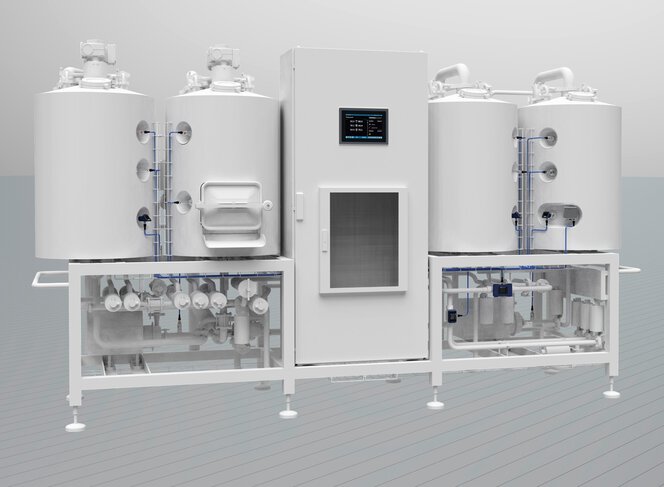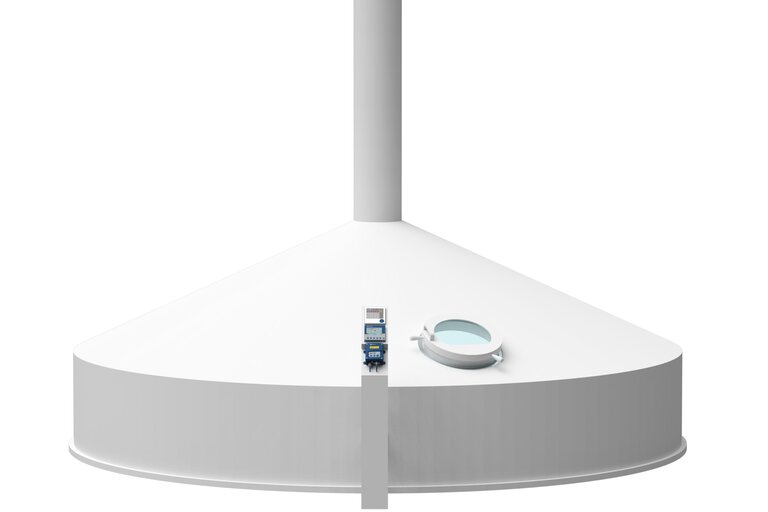

Bottoms Up: A Refreshing Pilsner to Celebrate JUMO's Anniversary
As an innovative technology leader, JUMO has been supplying high-quality measurement and automation technology for the food industry for decades. So it was an obvious idea to have our own anniversary beer created for the 75th anniversary in 2023. In the brewing process, all relevant JUMO products that are supplied to the brewing industry were to be combined in one application. The choice therefore fell on an in-house, modern, and highly efficient brewery plant.
Downloads
JUMO customers and partners can now enjoy a golden refreshing Pilsner with a pleasant bitter note. A special anniversary edition of the Pilsner will be available. And who knows? Perhaps in a few years individual bottles will be worth a small fortune.
A JUMO beer that comes from the region
In search of engineering expertise and a regional brewery capable of building such a plant and brewing such a beer, JUMO quickly came across Burkard und Gärtner (B+G), a specialist in plant design and plant engineering – as well as the company "Hunfelt Braeu". This young brewery on the outskirts of Fulda was founded in 2017 as a hobby in a garage. It has grown steadily since then and now produces 10 different specialties. "Hunfelt Braeu" sees itself as a small, regional brewery of specialty beers. Varieties include a stout, an India pale ale, and a barrel-aged Bock beer.
The idea of a "mini brewery" came about because Sebastian Gärtner, who is 1 of the 3 brewers, is also one of the owners of B+G on a full-time basis. So it made sense to combine JUMO's expertise with the expert knowledge of B+G and "Hunfelt Braeu" in a completely new plant in which the JUMO anniversary beer was then to be brewed.
Brewery plant is a classic 3-unit brewhouse
The planning of the plant on the basis of an intelligent 3D CAD model using the latest CAD/CAE software and manufacturing methods such as orbital welding technology meant that the project − which was mainly managed by trainees − was completed in just a few months.
This has resulted in a fully automated brewery plant in compact skid design which is completely made of stainless steel, has an output of 100 liters of cold wort, and which features an automated CIP function (Cleaning in Place). The brewery plant is a classic 3-unit brewhouse with lauter tun. Potential brew size is approximately 100 liters. Depending on the type of beer, this corresponds to a malt pour of approximately 20 kg.
In addition to the mash tun, lauter tun, and wort kettle, the plant was also equipped with a hot water tank. Apart from the lauter tun, all containers are electrically heated via the inner wall of the vessel. JUMO TYA 202 power controllers are used to control the heating elements. The power controllers are extremely important for efficient energy use.
Furthermore, the plant has a pump for water and the CIP function as well as another frequency-controlled pump for the mash or wort. In both pumps the JUMO ZELOS C01 LS level switch is used as dry-run protection.
The 2 motors for the mash tun stirrer and the lauter tun chopper are also frequency controlled.
When measuring the level of the hot water tank, mash tun, and wort kettle the new JUMO DELOS S02 pressure transmitter is used. The differential pressure measurement in the lauter tun was implemented with the JUMO TAROS S46 H.
JUMO flowTRANS W02 is used for quantity measurement of the main pour and the post pours. After the wort cooler, the new JUMO flowTRANS MAG HT20 measures both the totalized flow rate and the temperature. Temperature in the respective containers is determined with the JUMO dTRANS T1000.
The sensors were installed in the plant with the process connections G ½ (hygienic), JUMO PEKA (EHEDG certified), and clamp. It was integrated via SPE, IO-Link, or with 4 to 20 mA signal.
High degree of process reliability during brewing
At the beginning, the hot water container is filled with water and brought to the required mashing-in temperature. The water is then pumped into the mash tun and the malt grist is added manually. Water quantities (main pour) are determined with the JUMO flowTRANS US W01/02.
The mashing-in process should be completed in a time frame of less than 15 minutes and the stirrer should be running at maximum rotational speed. Enzymes contained in the malt now start the respective degradation processes. Part of the proteins are degraded by the proteinases down to amino acids while the starch is degraded to sugar by alpha and beta amylase. Enzymes work in a substrate-specific manner and place special demands on the reaction medium with regard to viscosity, pH value, and temperature.
The various pauses when having reached the respective optimal temperature are now passed through in accordance with the required beer type. A common mash process for pale beer today would be to mash in at 62 °C, after 50 minutes increase to 72 °C, and after another 20 minutes heat up to 78 °C. The heating process should take place with a temperature rise of 1 °C per minute. "The interaction of all these JUMO products and solutions ensures a high level of process reliability," says B+G manager Sebastian Gärtner.
After that, the lautering follows. In this process step, the liquid and solid components are separated from each other. When the lauter tun, which is equipped with a sieve bottom, is filled, the solids settle to the bottom to form a filter layer. The initially cloudy wort is pumped back into the lauter tun. When the wort is clear, a switch is made to the wort kettle. During the lautering process, the JUMO TAROS S46 H measures the differential pressure under the drop bottom to control the rotational speed of the frequency-controlled pump and to switch on the chopper if necessary.
After the main pour has been completed the post pours follow. The quantity of the individual post pours is acquired again via the JUMO flowTRANS US W01/02. Post-pouring is intended to remove any remaining extract from the spent grains. The sum of the extract that can be washed out and degraded should be less than 1 %.
In the subsequent process step, the wort is boiled for approximately 70 to 90 minutes. Boiling evaporates the water to obtain the required original wort, expels unwanted aroma substances, sterilizes the wort, inactivates enzymes, and forms aroma as well as colorants.
During boiling the hops are also added to the wort. This can be done in several individual hop dosages, depending on the beer and hop varieties. For bitter hops, the boiling process improves the dissolution of the bitter substances which is why they are usually added to the mix at the beginning. Aroma hops, on the other hand, are only added towards the end of boiling. The hop varieties used for the anniversary beer were magnum, ariana, and saphir.
After boiling the wort is cooled down to 20 °C. This is done with a countercurrent heat exchanger. At the outlet, the JUMO flowTRANS MAG H20 acquires both the totalized flow rate and the temperature. The rotational speed of the wort pump is controlled as a function of the wort outlet temperature.
After the preparation with yeast comes the fermentation and storage of the beer. Precise temperature control plays a particularly important role in fermentation. While beers with top-fermented yeast ferment between 15 and
20 °C, bottom-fermented yeasts ferment in a range of 4 to 9 °C.
JUMO digiLine CI HT10 determines concentration of cleaning media
Automatic cleaning of the equipment is also an option. The CIP function is made possible by such factors as concentration measurement of the cleaning media. JUMO digiLine CI HT10 determines the concentration of the different cleaning media via the temperature-compensated conductance in the hot water container.
Another measurement is used at the plant discharge to monitor the individual cleaning steps and media separation. First, the plant is preflushed with water via the spray heads in the containers. Subsequently, the cleaning steps with caustic soda, another rinsing with water, and neutralization with nitric acid or phosphoric acid follow. The last step is the final rinse with water until the conductance detects the complete removal of the acid at the outlet.
This is where the JUMO digiLine CI HT10 shows its strength. The accurate concentration measurement and short response time of the integrated temperature measurement contribute to the reduction of service water and cleaning agents.
CIP processes can also be carried out in a comparable manner in the pharmaceutical industry. In this case, the last rinse takes place with ultra-pure water. The conductance of the ultra-pure water is determined using the JUMO tecLine CR conductivity sensor and the JUMO AQUIS 500 CR transmitter. According to the specifications of USP 645 the temperature compensation can be deactivated in this case.
Control and visualization
Operation of the plant takes place via the JUMO variTRON 500 touch controller and the JUMO smartWARE SCADA software for process monitoring and control.
The recipes for the individual beer types as well as the individual CIP functions can be configured intuitively without programming skills using the browser-based software solution JUMO smartWARE Program. JUMO smartWARE Evaluation enables additional recording of all process parameters.
"Subsequently, both the brewing process and the CIP process can be evaluated and verified with an automated batch report," says Martin Eppinger, market segment manager for food and beverage at JUMO. This simplifies the brewing process for the next beer, which can then also be thoroughly enjoyed.
